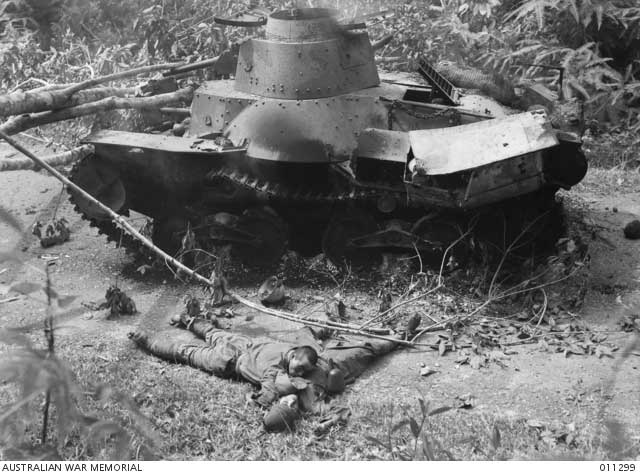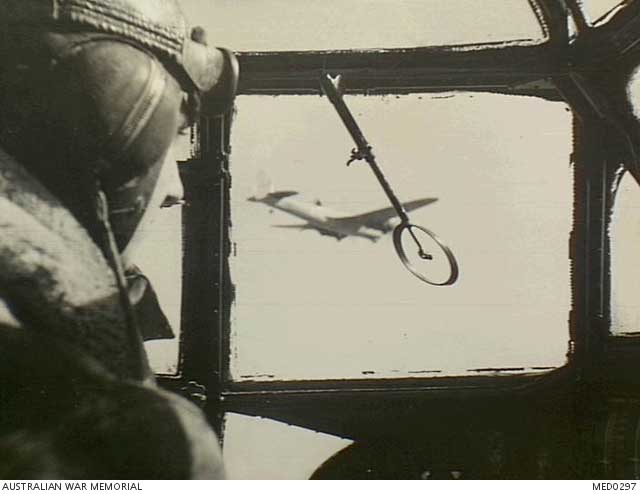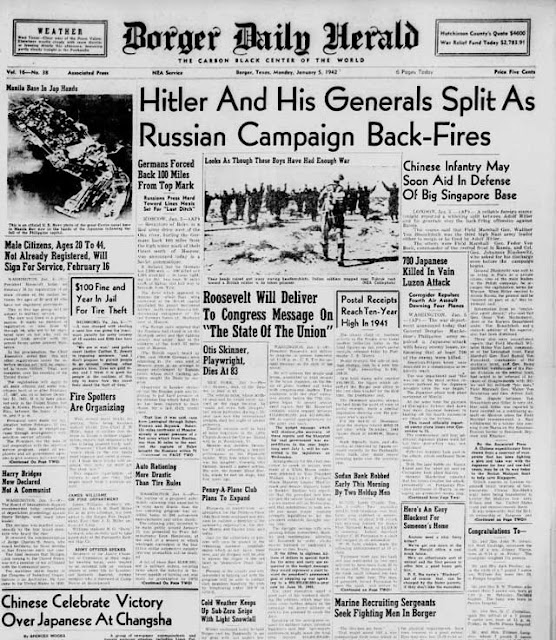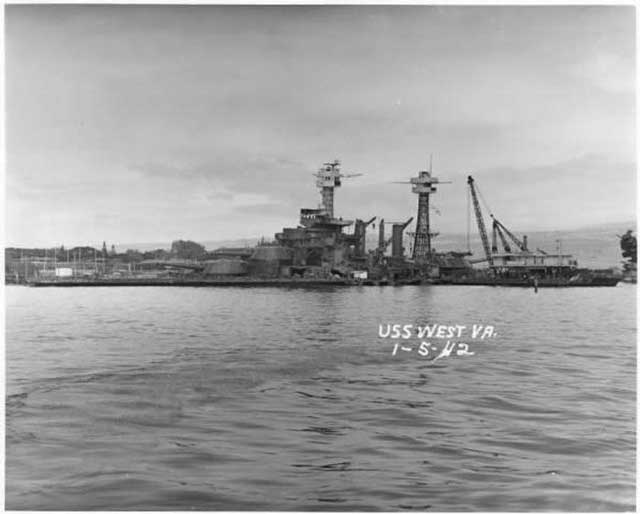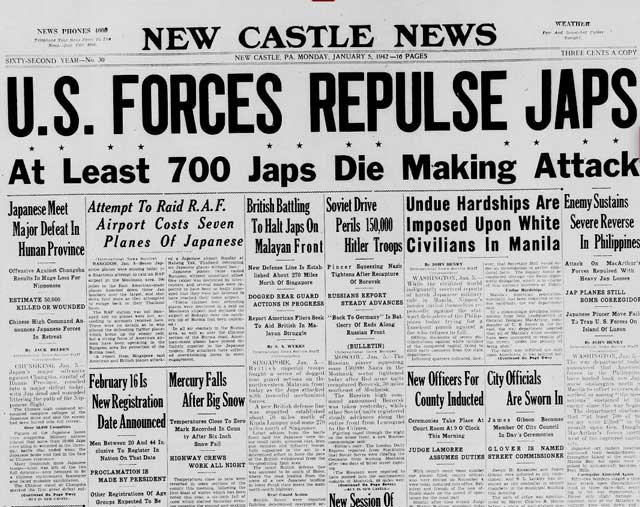Friday 30 January 1942
 |
| Troops unload a Junkers Ju 52 carrying desperately needed supplies into the Demyansk pocket, January 1942 (Ulrich, Federal Archive, Picture 101I-003-3446-16). |
Eastern Front: There are heavy snowstorms in northern Russia on 30 January 1942 which bring most operations on the Moscow sector to a halt. General von Mackensen's III Panzer Corps moves north in anything it can find to use as transport, while XI Corps moves east, both trying to cut off Soviet advances near Barvenkovo. There is little fighting today, and overall the poor weather aids the Wehrmacht's attempt to stabilize the front while the Soviets are having trouble capitalizing on earlier successes. The Soviet forces also are getting strung out as they cover much longer distances than the Germans do. The Red Army cavalry is moving much faster than the tanks and infantry, leaving them vulnerable for a riposte - if the Germans can get into position to deliver one.
 |
| The Singapore Causeway in the 1940s (National Museum of Singapore 1996-00396-063). |
Japanese bombers strike Keppel Harbor late in the morning. They damage four transport ships, including two that arrived on the 29th, USS Wakefield (AP-21) (destroys the sickbay) and USS West Point (shrapnel). They are waiting to take off supernumeraries and the damage they take shows the urgency of quick turnarounds in ports near the front lines. Each of the ships that can still make steam is loaded after the bombing attack, including the Wakefield despite its damage, and quickly head for Batavia, Java, Netherlands East Indies.
The Japanese also make progress in the Netherland East Indies, where they invade Ambon Island. Ambon is home to the second-largest naval base in the territory. The Dutch and Australian defenders accomplish little and fail to destroy key bridges and other infrastructure which might at least slow down the two major Japanese landings. Off the coast of West Timor, the Japanese shoot down a Qantas Short Empire flying boat, killing 13 of the 18 aboard.
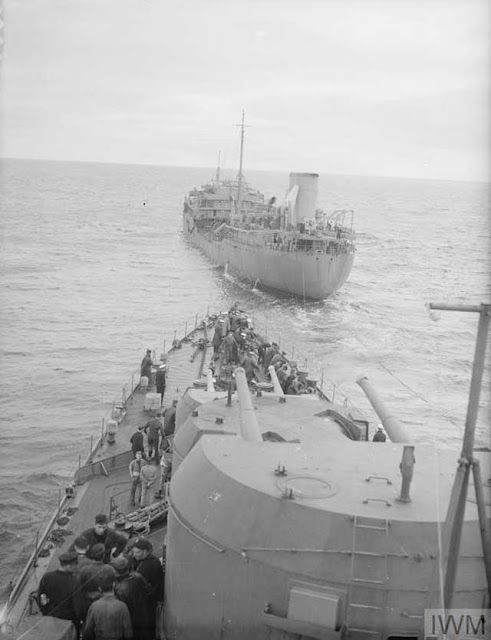 |
| "HMS HERMIONE getting into position to haul in towing wires." Hermione is being refueled by tanker RFA Dingledale (shown) somewhere in the Atlantic on 30 January 1942. (© IWM (A 7342)). |
 |
| Royal Navy aircraft carrier HMS Argus at sea in the North Atlantic, 30 January 1942. This photo was taken from cruiser HMS Hermione (© IWM (A 7338)). |
U-106 (Kptlt. Hermann Rasch), on its fifth patrol out of Lorient and operating about 150 miles (241 km) northeast of Norfolk, Virginia, uses its 10.5 cm deck gun to sink 6836-ton US tanker Rochester.
U-107 (Kptlt. Harald Gelhaus), on its fifth patrol out of Lorient and operating in the Atlantic east of Washington, D.C. and south of Nova Scotia, torpedoes and sinks 7419-ton British motor tanker SS San Arcadio. There are 41 deaths. Nine men are rescued by a PBM "Mariner" from Patrol Squadron Seventy-Four (VP-74). Some accounts place this sinking on 31 January 1942, but the National Museum of the U.S. Navy dates it as 30 January 1942.
US/Irish Relations: Officially noting the recent landings of American troops in Northern Ireland, the Irish government claims that its neutrality is being violated by their presence. The government statement calls the British government in Northern Ireland a "Quisling government" and rejects what it characterizes as British attempts to embroil it in the European conflict.
 |
| Adolf Hitler giving his 30 January 1942 speech at the Berlin Sportpalast. |
We are fully aware that this war can end only either in the extermination of the Teutonic peoples or in the disappearance of Jewry from Europe... The result of this war will be the complete annihilation of the Jews ... the most evil universal enemy of all time will be finished.It is a nihilistic war objective with hints of doom that clashes with the Propaganda Ministry's portrayal of the war as going well. He mentions casually that "I do not know if the war will end this year."
 |
| Bella Rodova, born in 1933 in Minsk, Belorussia (USSR). Perished on 30 January 1942 in the Berezino Ghetto, Belorussia. |
In Washington, D.C., President Roosevelt's cabinet holds a meeting about the internal security of the West Coast. The Hawaiian Commander, General Emmons, recommends deporting as many Japanese aliens and civilians from the islands as possible, but not before about 20,000 Caucasian women and children had been evacuated. Emmons is worried about the continuing Japanese presence but states that:
if an assault were made on Oahu before transfer of sufficient number of Nipponese, we have ready plans to immobilize the Japanese.However, Emmons does clarify that all Japanese considered threats based on real evidence are already being detained. The War Department orders Emmons to suspend the use of Japanese civilians by the Army, but he protests that these workers are absolutely necessary. The War Department then cancels the order. Evacuation of all Japanese from Hawaii, however, remains official policy. They total about 100,000 people.
 |
| The 30 January 1942 edition of The Palm Beach Post announces the opening of Ray's. |
The authorities on the West Coast continue to tighten restrictions on people classified as aliens of hostile foreign powers. Professional and business licenses of about 5000 people are revoked. While the individuals affected are mostly Japanese, there are fairly robust German presences in certain spots. These include San Francisco, the location of a German consulate, and Los Angeles, where certain German sympathizers maintained a compound (Murphy's Ranch) until it was shut down immediately after Pearl Harbor.
President's Birthday Balls are held across the United States. These are held in President Roosevelt's honor and raise funds to combat infantile paralysis or polio.
Future History: Martyn Jerel Buchwald is born in Cincinnati, Ohio on 30 January 1942. The Buchwald family later moves to San Francisco, California. In 1962, Buchwald begins recording with Challenge Records. He changes his name to Marty Balin, releases a couple of singles, and founds a folk music quartet. He is a major factor in the San Francisco music scene as the owner (with three equal limited partners) of a restaurant and later club called The Matrix. During this time, Balin assembles the group Jefferson Airplane as the club's house band. He serves as a lead singer (with Grace Slick). The group becomes a legendary rock act and goes through several name changes. Following a legendary career which includes induction into the Rock and Roll Hall of Fame in 1996, Marty Balin passes away on 27 September 2018.
 |
| Anona Winn is set to star in a new play, as reported in the 30 January 1942 Radio Times. |
1942
January 1942
January 1, 1942: Declaration By United Nations
January 2, 1941: Manila Falls to Japan
January 3, 1942: ABDA Command Announced
January 4, 1942: MacArthur on His Own in the Philippines
January 5, 1942: Soviets Plan General Offensive
January 6, 1942: US Army in Europe
January 7, 1942: Soviet General Offensive Opens
January 8, 1942: Hitler Sacks Hoepner
January 9, 1942: Battle of Dražgoše
January 10, 1942: Building the Jeep
January 11, 1942: Japan Takes Kuala Lumpur
January 12, 1941: Rommel Plans Counterattack
January 13, 1942: First Ejection Seat Use
January 14, 1942: Operation Drumbeat First Sinking
January 15, 1942: U-Boat Off NYC
January 16, 1942: Carole Lombard Crash
January 17, 1942: British Take Halfaya Pass
January 18, 1942: Soviet Paratroopers in Action
January 19, 1942: FDR Approves Atomic Bomb
January 20, 1942: The Wannsee Conference
January 21, 1942: Parit Sulong Bridge Battle
January 22, 1942: Parit Sulong Massacre
January 23, 1942: Japan Takes Rabaul
January 24, 1942: Battle of Makassar Strait
January 25, 1942: Kholm Surrounded
January 26, 1942: GIs Land in Europe
January 27, 1942: Battle of Endau
January 28, 1942: Rommel Takes Benghazi
January 29, 1942: First US Coast Guard Ship Sunk
January 30, 1942: Singapore Isolated
January 31, 1942: Army Group South Averts Disaster
2020




